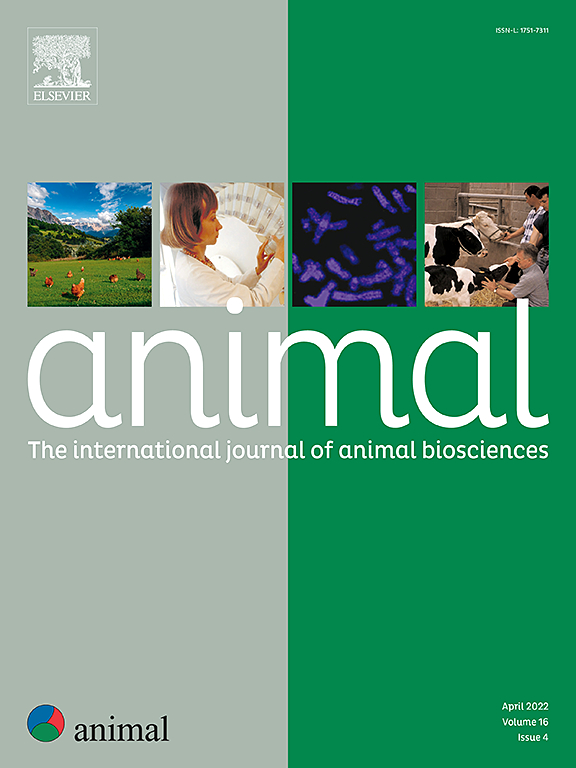The effects of incorporating sprouted barley in diets of high-yielding dairy cows on production, efficiency, and nutrient digestibility
IF 4.2
2区 农林科学
Q1 AGRICULTURE, DAIRY & ANIMAL SCIENCE
引用次数: 0
Abstract
The sprouted system is the process of growing grains hydroponically in trays. Recently, there has been interest in using sprouted grains as feed for ruminants. The objective of this study was to determine how including sprouted barley in dairy cow rations affects performance, nutrient digestibility, and efficiency. Forty-two mid-lactation Israeli Holstein dairy cows were divided into two treatment groups (n = 21) and fed for 12 weeks: (1) Control (CTL) – a typical milking cow ration contained 38.9% forage (DM basis) and (2) Sprouted Barley (SB) – a diet contained 33.7% forage, and 11.5% (DM basis) SB. Diets were fed as a total mixed ration. Milk yields and BW were recorded daily, and milk samples were taken for milk solid concentration. Rumen and faecal samples were taken for volatile fatty acid and digestibility measurements, respectively, and blood samples were taken for blood metabolite analysis. Milk yield was 4.1% higher (45.7 and 43.9 kg/d, respectively; P < 0.001) in the SB cows. Milk fat concentrations and yields were lower in the SB cows than in the CTL cows (3.82 and 4.10%, P < 0.001, and 1.69 and 1.77 kg/d, P = 0.04, respectively). Milk protein concentration was higher in the SB cows with no difference in protein yield, and the milk urea nitrogen was 17.0% lower in the SB cows (P < 0.001). The 4% fat-corrected and energy-corrected milk yields did not differ between treatments, and the DM intake (DMI) tended to be higher in the CTL (P = 0.08). The milk-to-DMI ratio was 6.3% higher in the SB cows (P < 0.001), with no differences in other efficiency calculations. The rumen ammonia concentration was 21% lower in the SB cows (P = 0.006), and rumen acetate, propionate, and total volatile fatty acids were higher in the CTL cows. Apparent total tract digestibility of DM, organic matter, and CP was higher in the SB cows (P = 0.003) and tended to be higher for NDF (P = 0.10). Lower blood levels in triglycerides, urea, and cholesterol were observed in the SB cows (P = 0.04). In summary, sprouted barley is a potential feedstuff; however, further research is needed to determine an accurate nutritional value of sprouted barley and to fine-tune the optimal amount in the high-yielding dairy cow ration. This essential knowledge is required to reliably determine the economic viability of using sprouts in ruminants’ nutrition.
高产奶牛日粮中添加发芽大麦对产量、效率和营养物质消化率的影响
发芽系统是在托盘中水培谷物的过程。最近,人们对利用发芽谷物作为反刍动物的饲料产生了兴趣。本研究的目的是确定在奶牛口粮中加入发芽大麦对生产性能、营养物质消化率和效率的影响。将42头泌乳中期的以色列荷斯坦奶牛分为2个处理组(n = 21),分别饲喂12周:(1)对照(CTL)为典型奶牛日粮,饲料含量为38.9%(干物质基础);(2)发芽大麦(SB)为饲料含量为33.7%(干物质基础),发芽大麦含量为11.5%(干物质基础),饲喂全混合日粮。每天记录产奶量和体重,并采集乳样测定乳固体浓度。分别取瘤胃和粪便进行挥发性脂肪酸和消化率测定,取血液进行血液代谢物分析。产奶量提高4.1%,分别为45.7和43.9 kg/d;P & lt;0.001)。SB奶牛的乳脂浓度和产奶量低于CTL奶牛(分别为3.82%和4.10%),P <;0.001、1.69、1.77 kg/d, P = 0.04)。SB奶牛的乳蛋白浓度较高,但蛋白质产量无显著差异,而乳尿素氮含量降低了17.0% (P <;0.001)。4%脂肪校正乳产量和能量校正乳产量在不同处理间无显著差异,干物质摄入量(DMI)在CTL中趋于较高(P = 0.08)。泌乳/ dmi比SB奶牛高6.3% (P <;0.001),其他效率计算没有差异。SB奶牛的瘤胃氨浓度降低21% (P = 0.006), CTL奶牛的瘤胃乙酸、丙酸和总挥发性脂肪酸浓度升高。SB奶牛DM、有机物和CP的表观全消化道消化率较高(P = 0.003), NDF的表观全消化道消化率有升高的趋势(P = 0.10)。SB奶牛血液中甘油三酯、尿素和胆固醇水平较低(P = 0.04)。综上所述,发芽大麦是一种潜在的饲料;然而,需要进一步的研究来确定发芽大麦的准确营养价值,并微调高产奶牛日粮中的最佳用量。为了可靠地确定在反刍动物营养中使用豆芽的经济可行性,需要这些基本知识。
本文章由计算机程序翻译,如有差异,请以英文原文为准。
求助全文
约1分钟内获得全文
求助全文
来源期刊

Animal
农林科学-奶制品与动物科学
CiteScore
7.50
自引率
2.80%
发文量
246
审稿时长
3 months
期刊介绍:
Editorial board
animal attracts the best research in animal biology and animal systems from across the spectrum of the agricultural, biomedical, and environmental sciences. It is the central element in an exciting collaboration between the British Society of Animal Science (BSAS), Institut National de la Recherche Agronomique (INRA) and the European Federation of Animal Science (EAAP) and represents a merging of three scientific journals: Animal Science; Animal Research; Reproduction, Nutrition, Development. animal publishes original cutting-edge research, ''hot'' topics and horizon-scanning reviews on animal-related aspects of the life sciences at the molecular, cellular, organ, whole animal and production system levels. The main subject areas include: breeding and genetics; nutrition; physiology and functional biology of systems; behaviour, health and welfare; farming systems, environmental impact and climate change; product quality, human health and well-being. Animal models and papers dealing with the integration of research between these topics and their impact on the environment and people are particularly welcome.
 求助内容:
求助内容: 应助结果提醒方式:
应助结果提醒方式:


